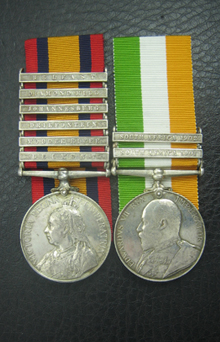
QUEEN’S SOUTH AFRICA 1899, CLASPS, BELMONT, MODDER RIVER, DRIEFONTEIN, JOHANNESBURG, DIAMOND HILL, BELFAST ‘CAPT. C. E. WYLD, CLDSTM: GDS:’, KING’S SOUTH AFRICA 1901, CLASPS, SOUTH AFRICA 1901, SOUTH AFRICA 1902 ‘CAPT. C. E. WYLD, CLD. GDS.’
M.I.D. London Gazette 10 September 1901
Charles Edward Wyld served as a Lieutenant in Major G.R.F. Smith’s No 3 Company, 1st Battalion, Coldstream Guards when they embarked for South Africa in 1899. He took part in the advance on Kimberley, including actions at Belmont, Enslin, Modder River and Magersfontein; operations in the Orange Free State, February to May 1900, including actions at Poplar Grove, Driefontein, Vet River (5 and 6 May) and Zand River; operations in the Transvaal in May and June 1900, including actions near Johannesburg, Pretoria and Diamond Hill (11 and 12 June 1900); operations in the Transvaal, east of Pretoria, July to 29 November 1900, including actions at Belfast (26 and 27 August); operations in Orange River Colony, November 1900 and April 1901; operations in Cape Colony, November 1900 to March 1901 and May 1901 to 31 May 1902; despatches London Gazette 10 September 1901 (Queen’s medal with 6 clasps; King’s medal with 2 clasps). Captain Wyld served for at least some of his time in South Africa as Brigade Signalling Officer; a photograph of him with other Officers of General Littleton’s Staff was published in ‘After Pretoria’.
A Regimental history notes him in command of Number 3 Company, from at least June 1901 and still noted as such on early 1902. He embarked for home in June that year. Captain Wyld retired to serve with the Imperial Yeomanry on 27 June 1903.
“The 1st Battalion sailed from Gibraltar on the Malta, and arrived at the Cape about 16th November 1899. Along with the 3rd Grenadiers, 2nd Coldstreams, and 1st Scots Guards, they formed the 1st or Guards Brigade under Major General Colvile. The work of the brigade has been sketched under the 3rd Grenadier Guards. At Belmont on 23rd November 1899 both battalions of the Coldstreams did well. Lord Methuen said: "The 1st Battalion Coldstream Guards attacked the ridge, S W of Mount Blanc. Colonel Codrington handled his battalion coolly and well". Three other officers were praised. In his report General Colvile says: "The battalion came under fire from 'Mount Blanc' at about 800 yards, and Lieutenant Colonel Codrington, swinging his left round to meet this, became committed to a frontal attack on 'Mount Blanc', which his battalion accomplished in a very brilliant manner with remarkably little loss. The battalion's losses were 7 men killed and 1 officer and about 20 men wounded".
At Modder River the 1st Battalion was at first in reserve, but soon had to extend the line to the right, and had to lie all day under a heavy fire. Their losses were about 20 wounded. Major Granville Smith was mentioned "for volunteering to find a ford, which he did in dangerous mud and a strong river". Four non-commissioned officers of the Coldstreams were mentioned, but their battalion was not given. At Magersfontein, 11th December (see 2nd Black Watch), the 1st Battalion was heavily engaged. Their losses were approximately 13 men killed, 5 officers and 50 men wounded. Colonel Codrington, who was wounded, "insisted on remaining in command of his battalion till nightfall". Major the Honourable W Lambton "refused to be carried because the bearers were exposed to fire; he remained on the ground for thirty-seven hours without food or water".
After the Guards Brigade returned from Koomati Poort the 1st Battalion was for a time at Heidelberg, and were thence railed to Cape Colony, where part of them were put into mobile columns, and thenceforth the battalion did much weary trekking and garrison work in Cape Colony until the end of the war. Naauwpoort and De Aar were the points where the Coldstreams were mainly employed during 1901 and the first six months of 1902.
Twenty - eight officers and 35 non - commissioned officers and men of the Coldstreams were mentioned in Lord Roberts' final despatch. These embraced both 1st and 2nd Battalions. In Lord Kitchener's final despatch 9 officers and 10 non-commissioned officers and men of the Coldstreams were mentioned.”
Condition: suspension soldered on QSA swivel; presumably swivel was loose as suspension/claw as issued, otherwise GVF. A good Guards Officer pair.